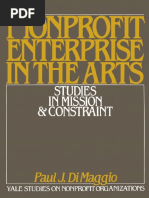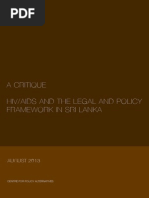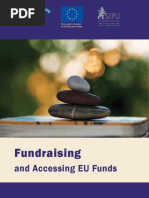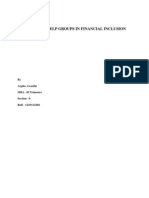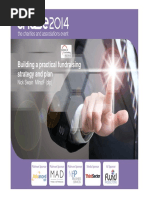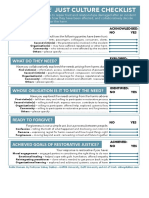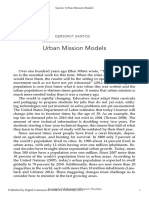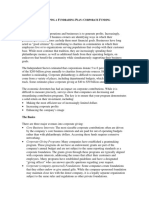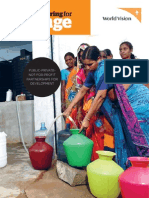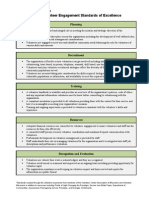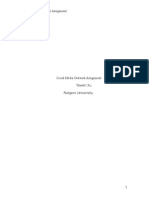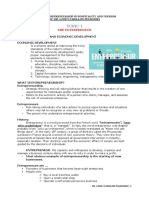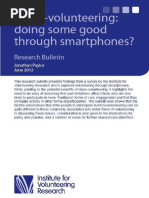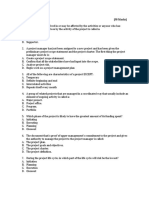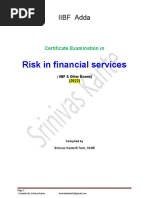Guide To Sustainable Funding
Guide To Sustainable Funding
Uploaded by
NCVOCopyright:
Available Formats
Guide To Sustainable Funding
Guide To Sustainable Funding
Uploaded by
NCVOOriginal Title
Copyright
Available Formats
Share this document
Did you find this document useful?
Is this content inappropriate?
Copyright:
Available Formats
Guide To Sustainable Funding
Guide To Sustainable Funding
Uploaded by
NCVOCopyright:
Available Formats
1342 Sust Fund
18/8/06
1:04 pm
Page i
Introductory Pack on Funding and Finance
Guide to Sustainable Funding
1342 Sust Fund
18/8/06
1:04 pm
Page ii
1342 Sust Fund
18/8/06
1:04 pm
Page iii
Contents
Page About this guide About the author Guide to symbols and abbreviations Introduction Why think about sustainability? 1 What is sustainable funding? 2 Effective planning and management The planning cycle Tool SWOT and PEST environmental analyses Tool Risk analysis Tool Business plan 3 Diversifying income The income spectrum Loan finance options Tool Income diversification diagnostic tool 4 Developing skills and capacity Organisational capacity and capability Tool Organisational capacity and capability assessment grid Skills and knowledge Tool Skills/Knowledge audit 5 Matching mission and money Sustainable funding in practice Case studies 6 Where next? Key words and phrases Further support and resources v vi vii ix 1 5 5 11 12 12 13 13 16 18 19 19 20 21 21 23 23 27 28 29
1342 Sust Fund
18/8/06
1:04 pm
Page iv
iv
1342 Sust Fund
18/8/06
1:04 pm
Page v
About this guide
This guide describes what is meant by sustainability and how organisations can plan for, and move towards it through sound financial management, awareness of available funding options, and development of appropriate skills. It provides an overview of the range of income sources available to voluntary and community organisations (including social enterprise) and examines how these different income sources relate both to each other and to the nature of the work organisations do. Finally, it describes how the stage in development an organisation has reached, together with its future plans, may highlight the most appropriate way of funding it. This is the first guide in the series that make up the Finance Hub Introductory Pack on Funding and Finance. Details of other guides are given below.
About the Introductory Pack on Funding and Finance
The Introductory Pack on Funding and Finance was commissioned by the Finance Hub, one of the centres of expertise created as part of ChangeUp1. The guides provide voluntary and community organisations and social enterprises with practical information, support and guidance on funding and finance options, and the skills needed to access these options. The guides have been designed with new and small to medium-sized organisations in mind. They aim to be accessible, clearly written and to explain any specialist terms used. They provide case studies highlighting real life experiences that offer good practice tips and the lessons learned by organisations that have been there and done that, including the first steps of some smaller organisations. The guides also contain tools and signposts to resources to assist organisations in their search for long-term financial sustainability. The guides that make up the Introductory Pack are: 1 2 3 4 5 6 Sustainable Funding Financial Management Fundraising Trading Procurement and Contracting Loans and Other Forms of Finance
Copies of the guides are available from NCVO and the Finance Hub. They can be downloaded from the Finance Hub website at www.financehub.org.uk or NCVOs website at ww.ncvo-vol.org.uk/sfp. Further details and information about the work of the Finance Hub and the support it provides is included in the Resources section at the end of this guide.
ChangeUp is a programme of capacity building for the infrastructure of the voluntary and community sector.
1342 Sust Fund
18/8/06
1:04 pm
Page vi
About the author
NCVOs Sustainable Funding Project
The Sustainable Funding Project is a first-stop shop encouraging and enabling voluntary and community organisations to explore and exploit a full range of funding and financing options to develop a sustainable funding mix. The project began in 2000 in partnership with Centrica plc and is now supported by the Big Lottery Fund, Triodos Bank and Charity Bank. The project also works in partnership with Futurebuilders England to build the sectors capacity to engage in public service delivery and to improve statutory funding practice. The Sustainable Funding Project was commissioned by the Finance Hub to design, develop and produce the Introductory Pack on Funding and Finance. For more information, ideas and inspiration see: www.ncvo-vol.org.uk/sfp
Introductory Pack authors, contributors and advisory group
The Introductory Pack has been developed by experts in voluntary and community sector funding and finance with input on design and presentation from practitioners including an advisory group of front-line funding advisors.
Series editor and project manager
Deborah Turton, Sustainable Funding Project, NCVO
Authors and contributors
Jim Brown, Baker Brown Associates Sarah McGeehan, Community Development Finance Association Paul Palmer, Cass Business School Laura Thomas, Institute of Fundraising Deborah Turton, Sustainable Funding Project, NCVO Centre for Charity Effectiveness, Cass Business School, City University Futurebuilders England
Advisors
Lynette Grant, Black Training and Enterprise Group (BTEG) Tarn Lamb, Cornwall Neighbourhoods for Change Mary Boucher, Gloucester CVS Esther Jones, High Peak CVS Stephen Awre, Sandwell CVO Sue Wright, St Helens CVS Thanks are also due to all the organisations that appear as case studies and to the members of NCVOs Sustainable Funding Team for their input, advice and support.
vi
1342 Sust Fund
18/8/06
1:04 pm
Page vii
Guide to symbols and abbreviations
Each section uses the symbols shown below. These are designed to help readers navigate through the text and to highlight key points and signposts.
Good practice tip/key points to remember
Tool (e.g. template or checklist)
Signposts to further support and information
CVS = council for voluntary service VCO = voluntary and community organisation VCS = voluntary and community sector
vii
1342 Sust Fund
18/8/06
1:04 pm
Page viii
viii
1342 Sust Fund
18/8/06
1:04 pm
Page ix
Introduction Why think about sustainability?
All organisations, large and small, rural and urban, private and public sector as well as the voluntary and community sector (VCS), need money, resources and people. The people do the work, the resources enable it to happen and the money, underpinning it all, pays for it. No individual can survive on thin air, and neither can organisations, no matter how worthy, publicly beneficial, or intensely needed their product or service. At the same time, just because an organisations work is vastly beneficial and needed by society does not mean it will automatically receive funding. This is not necessarily because funders do not think it deserves funding, or do not want to support it. Quite often, there simply isnt enough money to fund everyone. Alternatively, it might be that those who can supply money (whether funders, donors or the purchasers of services) attach certain criteria to their funds, or expect certain things in return. Donors may only give to causes they personally believe in. Grant funders might require organisations to demonstrate their ability to manage funds effectively and to achieve certain stated aims. A statutory purchaser within a local authority may buy services from an organisation solely on the basis that its services meet certain standards in terms of quality and customer focus, or contribute to targets set by the Government to deliver a particular social policy initiative. Add all these together and it is easy to see that some organisations, working in some areas, might be more or less likely to receive funding than others. Again, nothing to do with how good or bad they might be (although this could be a factor), but purely on account of the circumstances, wider environment and other factors that might determine whether or not they receive funding. It is because voluntary and community organisations (VCOs) live in just such an uncertain funding environment that sustainability should be a top priority for all groups whether just starting out, or having been in existence for years. Organisations typically want to continue helping their beneficiaries long into the future, but to do that they need to consider how they will fund their activities, and keep on funding them. Sustainability is not achieved simply by winning one large grant or by recruiting a number of rich donors. Sustainability requires ongoing systematic planning and preparation together with an understanding of what funding opportunities are available, how these funds can be tapped into, and what skills might be needed to access and manage these funds. Sustainability is something every organisation needs to think about and work towards. The aim of this guide and the others within the Introductory Pack on Funding and Finance is to help organisations to understand how this can be achieved.
ix
1342 Sust Fund
18/8/06
1:04 pm
Page x
1342 Sust Fund
18/8/06
1:04 pm
Page 1
1 What is sustainable funding?
Sustainability is not just about money. Too often sustainable funding is seen as a question of simply getting better at fundraising or locating one ever-lasting source of income. Instead, it should be seen more as a strategic and holistic approach to ensuring the ongoing viability of an organisation its about exploring funding in the round. This rounded approach encompasses effective planning, diversifying an organisations income where possible, building organisational skills and capacity to ensure the best and most effective use of resources, and pursuing the most appropriate income opportunities for the kind of work an organisation does.
Planned and well managed
Sustainability begins not with money but with planning.
Sustainability requires, and is underpinned by, effective organisational planning and management. This includes developing sound financial management systems and the ability to accurately analyse an organisations full costs (rent, utilities etc in addition to discrete project related expenses). The ability to assess a projects longer-term outcomes (not just its immediate activities) and to monitor performance can also be beneficial. This is in addition to understanding what other skills and developments might be needed to ensure an organisation continues to fulfil its mission well into the future, including beyond the timeframe of any immediate funding. If an organisation hasnt spent time planning where it wants to be in three, five or ten years time, how can it know the type or amount of funding it really needs? Planning and management skills are further explored in section 2, Effective planning and management.
Diverse
Income diversification means having a range of income sources so as to avoid reliance on any one of them.
A key factor enabling VCOs to become more financially sustainable is having a range of income streams. This is often referred to as diversification (or in other words, not putting all your eggs in one basket). Although a major grant from a big funder is incredibly useful, if this is an organisations primary source of income, what happens when that grant comes to an end? Alternatively, what if the funder changes their criteria, or the organisation finds a need for a service which funders do not want to support? Sustainability requires several income streams, so that if and when one source of income dries up, others enable an organisations valuable work to continue and/or provide a cushion while new sources of money are sought. The range of income streams available to VCOs stretches from donations and grants to contracts to deliver services and income from trading. There are also opportunities for organisations to grow using loans.
1342 Sust Fund
18/8/06
1:04 pm
Page 2
In practice, and depending on the nature of what an organisation does, diversification might involve getting money from one, several or all of these sources. Diversification also applies within each income type. For example, even if an organisation survives almost solely on contract income it makes sense for it to have several different contracts rather than relying on just one. The range of income streams and other finance mechanisms available to VCOs is further explored in section 3, Diversifying income.
Enabled with the right skills
Developing the right organisational skills promotes access to new sources of income and benefits organisations more widely.
Sustainability also involves organisations positioning themselves to access and successfully manage new types of income. Trading, for example, requires marketing skills to promote products and understand potential customer need. Generating income from contracts might mean building relationships with potential purchasers and learning how to tender for contracts, but also having the confidence to walk away from contracts which fail to meet organisational requirements like fully meeting costs. The important thing to remember is that building skills to access new income streams is not a drain on time or resources. Skills development benefits organisations more widely, building capacity to better meet beneficiary need. Developing skills and organisational capacity is further explored in section 4, Developing skills and capacity.
Appropriate
Sustainable funding includes using the right income streams to drive development at the right time.
Having a range of income sources is not the only answer. The kind of funding an organisation needs, and which will suit it best, also comes down to what it does, who it does it for, and how it plans to develop in the future. Understanding when different income streams are appropriate encourages a more sophisticated approach to income diversification. A grant, for example, may be suitable for paying the salary of a new manager for an expanding service. However, keeping the manager on the pay-roll once the initial grant funding runs out, or indeed continuing the service itself, might require tendering for a contract with a local authority purchaser to continue funding for delivering the service to the local community. In the above example, such income diversification is only possible because contract funding often suits organisations delivering some form of public service. In the case of an organisation solely concerned with campaigning, for instance, grants, donations, or income gained from trading might be more appropriate avenues to consider. Similarly, an organisation wishing to purchase a building or undertake substantial renovation work might find a loan a more appropriate way of financing such activities.
1342 Sust Fund
18/8/06
1:04 pm
Page 3
Organisations need to consider which funds are most useful for the kinds of work they do and for the objectives they wish to achieve, and when other income streams would actually be more suitable and, ultimately, sustainable. Matching income with work area and developmental need is further explored in section 5, Matching mission and money sustainable funding in practice.
Different for each organisation
There are no magic answers to becoming sustainable, no simple solutions and no pots of gold every group and organisation is unique. Equally, there are no guarantees of survival, but planning effectively, avoiding reliance on one source of funding, building organisational skills and capacity, and choosing income streams that are appropriate for the work an organisation does and goals it wants to achieve, go a long way towards it. The rest of this guide unpicks these steps and signposts to relevant support and resources. Case studies illustrating sustainable funding in practice are included in section 5, Matching mission and money.
Summary What is sustainable funding?
Sustainable funding isnt about locating one ever-lasting source of income. It is an approach that explores funding in the round. This approach begins with strategic planning. Sustainable organisations pursue opportunities for diversification across the spectrum of income streams available to VCOs, exploring all the available options. Achieving sustainability goes hand-in-hand with effective financial management and wider skills development. With that comes the capacity to access, manage and plan for new income opportunities. Sustainable funding involves thinking about what is the most appropriate way to fund your organisation.
1342 Sust Fund
18/8/06
1:04 pm
Page 4
1342 Sust Fund
18/8/06
1:04 pm
Page 5
2 Effective planning and management
Planning should be the cornerstone of everything an organisation does. Similarly, sustainability begins not with funding, but with planning, supplemented by effective management of resources. Before organisations start thinking about money, they need to decide what their mission, aims and goals are and plan how they will achieve these. Only once an organisation knows what it wants to achieve, and has planned accordingly, can it determine which income streams are most appropriate for meeting its aims, and begin to pursue them.
The planning cycle
A useful way to approach planning is to implement a planning cycle. Below is the planning cycle outlined in Tools for Tomorrow A practical guide to strategic planning for voluntary organisations, developed by the Centre for Charity Effectiveness at Cass Business School, City University and NCVOs Third Sector Foresight project. This divides the planning process into six key stages enabling organisations to take planning one step at a time:
Figure 1 The planning cycle
1
Getting the direction right: periodic
6
Evaluation: ongoing
2
Environmental analysis: periodic, ongoing and annual
5
Implementation: ongoing
3
Options and choices: annual
4
Business planning: annual
The following paragraphs outline each stage. Tools outlining the exercises highlighted in bold follow at the end of the section for organisations to use in their own planning.
1342 Sust Fund
18/8/06
1:04 pm
Page 6
Stage 1 Getting the direction right
Establishing or restating a VCOs mission and objectives is crucial to keeping it on track and in touch with service users.
The first step in the process is to make sure that the direction in which an organisation is moving is the right one and meets the needs of all stakeholders, including service users, staff, volunteers and trustees. Achieved by: Establishing or referring to an organisations mission statement and its original vision. Ensuring that the values are still pertinent and championed throughout the organisation, and if not, consulting all stakeholders to revise and refresh. Establishing a consensus on what an organisation wants to achieve. When revising or establishing an organisations mission, all the relevant stakeholders should be consulted, both internally and externally. Everyone who works in the organisation including volunteers, service users and beneficiaries need to be asked where they think the organisation currently sits, where it is going, and most importantly of all, where it should be heading. Hand-in-hand with direction setting goes establishing what it is an organisation wants to achieve. These aims are often referred to as outcomes. Outcomes are changes in a service user or target group, not discrete outputs or activities. For example, if an organisation delivers training, their outcomes might be trainees going on to secure employment or entering further education, not simply the number of courses they have run. Establishing what outcomes an organisation wants to achieve early on makes it easier for systems to be put in place to monitor and evaluate the extent to which it is achieving its aims. Such monitoring helps VCOs to both continually improve services for users and to produce evidence that demonstrates their achievements, providing strong arguments as to why funders, purchasers or investors should support their particular organisation. Re-assessing the direction of an organisation should be carried out once every five years or so, unless the environment in which it operates is changing rapidly, in which case this exercise may have to be carried out more frequently. Outcomes should be established both for an organisation overall and for specific projects or activities.
1342 Sust Fund
18/8/06
1:04 pm
Page 7
Stage 2 Environmental analysis
Being aware of your internal and external environment is the first step in dealing with potential problems and identifying future funding opportunities.
No organisation can ignore the environment in which it operates. Environmental analysis highlights the challenges and opportunities an organisation may face, and accesses how fit the organisation is to carry out its work in such an environment. Achieved by: Looking at the organisation internally and externally, noting both the current situation and the likely future (SWOT and PEST analyses). Using this assessment of what is going on now and in the foreseeable future, both inside and outside to underpin future decision-making. The external environment includes: The Government and emerging policies Economic trends New government legislation Society and demographics Clients/beneficiaries and their needs Other market players Purchasers Suppliers
There are many potential internal inhibiters that might derail an organisation. These include any cultural changes that might need to take place in order to take the organisation forward, training requirements of staff and volunteers that need to be addressed, insufficient resources, or new funding priorities.
Stage 3 Options and choice
Options arent just about choice; they are also about priority, feasibility and risk assessment.
Analysing an organisations internal and external environment will generate a range of ideas about potential future activities and funding options; and a list of things it could and should be doing. These options need to be explored so that an informed decision can be made about the actions needed to achieve the desired future. A risk analysis is a useful way of assessing options. Achieved by: Assessing the pros and cons of the various options available. Making decisions on which of the options best fits with an organisations goals. Assessing the practicalities of what is achievable, including costs.
1342 Sust Fund
18/8/06
1:04 pm
Page 8
Stage 4 Business planning
Business plans should be accessible to all and contain information that is both proportionate and relevant to the options chosen by the organisation.
Once an organisation has generated information about its aims, environment and options it needs to review this and begin mapping out plans for its next steps in detail, perhaps in the form of a business plan. Plans do not need to be long and formal, but should be accessible (i.e. written in a language that everyone can understand). Information should be proportionate and relevant (e.g. only use graphs and figures that help tell the story). This is when options and choices about the future start turning into reality, and creating the framework in which an organisation will carry out its work. Achieved by: Developing goals and targets. Capturing the strategy in some kind of written document. Thinking about the resources required to deliver the plan. A full understanding of an organisations cost base is fundamental to its long-term sustainability. Fully costing ongoing and new activities is therefore crucial to it being able to serve its beneficiaries in the long-term. Cash flows and budgets also need to be considered at this stage and should be an accurate reflection of what it will cost an organisation to deliver a particular service or product.
Stage 5 Implementation
It is at the implementation stage that organisations finally start translating plans into action towards accessing funds and managing them effectively.
Once decisions have been made about the future direction and once the actions needed to achieve the desired future have been identified, these decisions and actions (often expressed as goals, targets and outcomes) need to be built into an organisations everyday life; i.e. embedded in the systems and processes of the organisation. VCOs also need effective financial and performance management systems to ensure they stay on track and are able to demonstrate their effectiveness and track record to potential funders, purchasers or investors. Financial management stretches from effective budgeting, and knowing when money is expected in to and out of an organisation to the ability to use financial information to make informed management decisions. A detailed introduction to financial management is provided in the Introductory Pack Guide to Financial Management. Achieved by: Identifying desired outcomes and how these will be assessed (see below). Applying for appropriate funding. Recruiting or training staff and allocating resources.
1342 Sust Fund
18/8/06
1:04 pm
Page 9
Stage 6 Evaluation
VCOs should be clear about what they want to achieve and be able to demonstrate it, with evidence, to themselves, and to funders and/or investors. Once the strategic plan is firmly embedded throughout an organisation, it is time to take stock and evaluate what works well, and just as importantly, what doesnt work as well. Achieved by: Outcome monitoring via stakeholder questionnaires, focus groups, feedback. Outcomes monitoring helps organisations to plan things better and to meet beneficiary need more effectively. At this stage an organisation considers the extent to which it has achieved what it set out to do. Information gained here can help show an organisation where it can improve things in the future as well as demonstrate its effectiveness to potential funders. The evaluation stage is the ideal time to identify what the next issues are for the next round of the planning cycle. To succeed, organisations need to be clear about their objectives, understand the desired outcomes of their work, and be aware of opportunities and challenges on the horizon. Having a clear strategy clarifies funding possibilities and will support any future funding applications, or steps towards earned income. Finally, it should be noted that planning is relevant and important to everything an organisation does, not just in terms of financial sustainability. The planning cycle and associated Tools outlined below can be used throughout an organisation from big picture strategy to planning individual activities.
Summary Effective planning and management
All organisations need to plan no matter what their size. Planning highlights opportunities as well as challenges, giving organisations time to prepare for them. Planning helps organisations approach income generation strategically, merging mission with money to support beneficiaries more effectively. Strategic planning is essential for ensuring future development and direction follows naturally from an organisations mission. Planning is relevant and important to everything an organisation does.
1342 Sust Fund
18/8/06
1:04 pm
Page 10
Further support and resources
Available from NCVO unless otherwise stated Planning Copeman C, et al (2004) Tools for Tomorrow A practical guide to strategic planning for voluntary organisations. NCVO. London. Voluntary Sector Strategic Analysis (annually). NCVO. London. Outcomes Cuppitt S, and J. Ellis (2003) Your Project and its Outcomes. CES. London. Available at: www.biglotteryfund.org.uk/project_outcomes.pdf Information on outcomes monitoring within infrastructure agencies, including example assessment templates can be found in: Burns S, and D. Turton (2006) Distance Travelled: The experience of outcome monitoring within NCVOs Sustainable Funding Project. NCVO. London. Financial management Palmer P, (2006) Introductory Pack Guide to Financial Management. NCVO. London. Full-cost recovery A method for calculating, and practical guide to understanding and analysing, full costs is provided in: Full Cost Recovery: A guide and toolkit on cost allocation (2005) New Philanthropy Capital and ACEVO. London. The guide includes a cost allocation template to help organisations calculate the full costs of their projects and services in an easy step-by-step process. It is available in hard-copy or as an interactive CD-Rom from www.acevo.org.uk
10
1342 Sust Fund
18/8/06
1:04 pm
Page 11
Tool SWOT and PEST Analyses
SWOT Strengths Weaknesses Opportunities Threats Once the organisations mission has been established, think through and brainstorm, possibly in a team meeting or staff or Board away day, your future direction and what you want to achieve. Use a flip chart to capture information under these four headings:
Strengths What do we do well and have working in our favour? Opportunities What trends or changes in the external environment could we take advantage of?
Weaknesses In what areas is our performance not so good? Threats What trends or changes in the external environment could have a negative impact on us?
Refine list by considering what is really important high priority issues. Consider implications what will it mean for the organisation and users? Consider how positives can be accentuated and negatives minimised. PEST Political Economic Scientific Technological PEST Analysis works exactly the same way, but uses the headings given below. It is more focused on highlighting external issues which may impact upon an organisation, or that could become opportunities for it.
Political Public policy agenda Legislation National and local government issues
Economic Funding trends Costs (e.g. staff) Competitors for services
Social Public attitudes Demographic changes International situation
Technical Advances, change, wider access Skill requirements New approaches
11
1342 Sust Fund
18/8/06
1:04 pm
Page 12
Tool Risk Analysis
Assessing risks and anticipating how an organisation might deal with them is half the journey towards prevention or reducing their potential impact. It can also help with understanding the options for an organisation. Using the headings below, list all the risks potentially facing the organisation (example given for guidance).
Risk e.g. volunteers unable to commit for long periods
Likelihood Medium
Impact High
Mitigation Provide training incentive, recruit more volunteers
Assess likelihood and potential impact, rate high, medium or low. Consider how these risks can be avoided or overcome the mitigation. What are the implications of these findings? What immediate action should be taken? What can be influenced?
Risk analysis is beneficial in helping an organisations management staff fulfil their obligations of protecting and preserving the organisation and advising the board of Trustees on future courses of action.
Tool Business Plan
Use the headings suggested below as the starting point for producing a written document outlining what an organisation or project intends to do. It should illustrate why a VCO is best placed to deliver that work, and make a case for why a funder, purchaser, or investor should support them financially. An overview of the proposed scheme Why the scheme is needed Why this organisation? Scheme description Scheme outcomes Staffing and management structure Budget Funding and marketing plan Risk assessment (see risk analysis above)
12
1342 Sust Fund
18/8/06
1:04 pm
Page 13
3 Diversifying income
A key element of sustainability is to know what income streams are available and be open to new approaches.
Based on their planning, organisations should begin to have a sense of the kind of money they need large or small amounts, income to fund a specific project or extend a piece of work, money to pay for general office maintenance and administration, long and short-term. The next step is to understand the kind of money available.
The income spectrum
The income spectrum in Figure 2 illustrates the range of income streams available to voluntary and community organisations. Figure 2 Spectrum of income options available to VCOs
Donor
Funder
Purchaser
Consumer
Gift Economy
Grant Funding
Structured Market
Open Market
ASKING
EARNING
Different income streams are accessed and managed in different ways and involve different relationships with the individual or organisation supplying the funds. Moving across the spectrum from left to right from asking to earning the level of expectation regarding what is received in return for the income increases. In addition, the skills needed to access money from each income stream also varies; for example the ability to fill in a form may be useful to winning grant funding, but understanding how to negotiate a contract, or being able to demonstrate how an organisation meets certain quality standards, might be needed to obtain funds within the structured market. Sustainable funding can involve all potential income streams, or a more limited range diversification can occur both across the spectrum and/or within a particular stream.
13
1342 Sust Fund
18/8/06
1:04 pm
Page 14
Gift economy
Gift economy income comes from donors. These can be individuals or corporate businesses. Other names for this income type are voluntary income or charitable giving. The gift economy provides unrestricted income in other words, funds that can be used at the VCOs discretion to further its charitable aims, rather than being tied in advance to specified projects or activities. In giving, a donor is not expecting a specific return for their investment, instead they are providing general support to help an organisation do its work as it sees fit. Suitable for: The gift economy can be an ongoing income stream, it is likely to be used by all VCOs, large and small, but large and expanding organisations are unlikely to rely solely upon it. Small groups, those just setting up, or any organisation starting a new small project often rely on the gift economy, but other income streams should also be explored. VCOs working in areas likely to attract individuals personal support (e.g. animal sanctuaries, support for child sufferers of cancer) can be particularly successful. Accessed via: Traditional fundraising. This is explored in the Introductory Pack Guide to Fundraising.
Grant funding
Grant funding is more likely to be tied to specific objectives and is supplied by designated funders. These may be independent (e.g. a Trust or Community Foundation), statutory (e.g. a local authority) or corporate (e.g. a private business like Centrica or Laura Ashley). Grant funding is usually restricted; it can only be used for the purposes for which it was requested. To ensure this, grant-makers are likely to request monitoring reports on how their money has been spent and what has been achieved with it. Some funders, such as the Lottery funders have guidelines about how money is spent, which may have implications for managing a grant and accounting for it. Longer-term activity, or activities which are at an early stage in development, often find it harder to attract grants. Grant-makers policies may result in priorities for giving which do not match all VCOs needs. Stiff competition for this type of funding also makes it increasingly difficult to obtain. Suitable for: Grant funding suits projects that have a clear start and end point and clearly defined outputs and outcomes. Grant funding can also be used effectively to try out something new (e.g. a project which, if successful, could later be financed through other sources such as a contract). Accessed via: Completing a funders dedicated application form or, for smaller Trust funds, providing a detailed outline of the work or project for which funds are sought. Larger grant applications require the submission of a business plan and usually involve several stages, including an assessment visit. Training courses such as those run by the Institute of Fundraising can help with grant applications. Local Councils for Voluntary Service also usually provide support for completing applications and can provide access to a database of grant funders.
14
1342 Sust Fund
18/8/06
1:04 pm
Page 15
Structured market
Earned income is money gained from selling a product or service. It can be obtained from delivering a service under contract or from trading (selling a product or service on the open market). The structured market involves earning income from payment for goods or services delivered according to the terms set out in a contract between a VCO and a third party known as a purchaser. In some cases an organisation may be offered what is termed a service level agreement (SLA). VCOs can deliver goods and services under contract to purchasers from the public or private sector, or to another voluntary organisation. The kind of purchaser involved will probably determine how the funding is regulated. Providing public services under contract is a big growth area of this type of funding. Suitable for: Delivering services under contract is potentially open to any organisation, yet the biggest opportunities are currently for those that work in areas associated with public services (i.e. services usually funded by the public purse). These might include social care, child care, provision for the elderly or disabled, recycling or other services which a local authority may be interested in purchasing. Services can also be sold under contract to private businesses or other VCOs (e.g. a contract to provide training). Contractual income can be a means of sustaining and expanding a service initially piloted using grants (see for example the Complementary Health Trust case study in section 5). Accessed via: Preparing a business plan and tender for a contract, usually within a tendering process outlined by the potential purchaser. Local authorities often advertise potential tenders in the local press. Developing good working relationships with potential purchasers is crucial. A good relationship can be a useful route to finding out about tenders and understanding what a particular purchaser is looking for. This area is further explored in the Introductory Pack Guide to Procurement and Contracting.
Open market
At the opposite end of the spectrum to the gift economy is the other major area of unrestricted income: the open market. When trading goods and services in the open market, VCOs are using a business approach, earning income directly from customers. There is practically no limit to the range of goods and services VCOs can sell. Some types of trading are undertaken purely to generate profit; some may also further the goals of an organisation, e.g. Traidcraft goods provide a living wage to farmers in developing countries. Ideally, trading should unite providing a product or service which furthers a VCOs mission with generating income. Suitable for: Any organisation can trade, what varies is the scale, scope and nature of product or service sold. The key to success is identifying a potential market and a product that people will purchase. Trading can be small-scale (e.g. selling posters and education packs to disseminate information to schools attending a theatre) or large scale (e.g. setting up a separate trading arm to manage a consultancy or training service or opening a charity shop). Accessed via: Planning and starting some form of trading activity. This can be large or small-scale depending on a VCOs mission and needs. Small-scale trading is not unlike some fundraising, however larger initiatives may require skills development within an organisation and start-up finance (see below). This area is further explored in the Introductory Pack Guide to Trading.
15
1342 Sust Fund
18/8/06
1:04 pm
Page 16
Loan finance options
Loans are not an income source, but a finance tool or enabler, helping organisations to grow, bridge a gap in funding, or support a fundraising drive. The latter half of the spectrum (contractual and traded income) is often underpinned by loan finance supplied by investors. This is because expanding to take on contractual work, developing trading initiatives, or simply increasing the scale and scope of an organisations work often requires investment (e.g. to train staff in new skills, or purchase equipment). Such investment, however, can be the means to opening new income streams. Major purchases such as capital development (e.g. purchasing or renovating a building), or working capital to enable development or expansion can also be financed using a loan. There are, however, additional opportunities for VCOs to use loans. These include bridging loans which can help an organisation through short breaks between receipt of grant payments. Loans can also support major fundraising drives where a loan is used to enable a VCO to get on with a project (e.g. producing an information video) while funds which will repay the loan are raised by more traditional means. This can be particularly useful where waiting while money is raised means an organisation risks missing an opportunity. Suitable for: Loans are suitable for organisations which will subsequently have access to income from which they can repay the loan. This may be generated from contractual work or trading, but could also be from major fundraising activity or, in the case of a bridging loan, simply when the next grant arrives. Accessed via: Approaching a bank, community-based lender, or specialist VCS lender such as the new loan finance packages of loans and grants available from Futurebuilders or the Adventure Capital Fund. These and other loan schemes are explored in depth in the Introductory Pack Guide to Loans and Other Forms of Finance. Within the range of options described in the income spectrum, the variety of loan initiatives available, and within each income type itself, there is enormous scope and possibility. As each VCO is unique, so the options open to them will be different, and may change according to the types of activity they are doing and the stage in the organisations development.
16
1342 Sust Fund
18/8/06
1:04 pm
Page 17
Summary Diversifying income
The income spectrum illustrates the range of money available to VCOs: Gifts. Grants. Earning from contracts or SLAs within a structured market. Earning from trading on the open market. Sustainable organisations are those that diversify as broadly as possible across and/or within the income spectrum. Loans are also an option, providing financial investment to enable organisations to develop or expand, bridge a gap in funding, or support capital fundraising.
17
1342 Sust Fund
18/8/06
1:04 pm
Page 18
Tool Income diversification diagnostic tool
Find out the extent to which an organisation relies on a particular income stream or funder by completing the template below. Take a few minutes to review current income streams and assess whether a more diverse funding approach could benefit the organisation and its beneficiaries. Consider diversification across the income spectrum or, if that is not possible or appropriate at this stage, within a particular stream.
Income stream Donations Individuals Private sector Grants Trusts and Foundations Public sector agencies Private sector Contracts/SLAs Voluntary organisations Public sector agencies Private sector Trading Individuals Voluntary organisations Public sector agencies Private sector
Number of providers
Funding length
Amount
Level of Dependency Low Medium High <10% <50% >50%
18
1342 Sust Fund
18/8/06
1:04 pm
Page 19
4 Developing skills and capacity
Building organisational skills and capacity can also promote access to new sources of income.
The key to financial sustainability is the realisation that it is not just about money. Increasingly sustainability is about organisations positioning themselves to access new income streams by thinking and acting strategically. This often means assessing and developing organisational skills and capacity. For example, trading requires marketing skills and understanding your customers. Contractual income demands relationship building with potential purchasers. Implementing full cost recovery may require negotiation skills. This also reiterates the importance of planning only when an organisation systematically considers what it wants to achieve, is aware of the environment in which it operates, and can articulate what it needs to do to achieve its goals, will it be in a position to understand what skills or additional resources may be needed to help it move forward. Different skills may be needed to access and manage different types of income. The starting point to understanding what skills a VCO might need to develop is to assess current capacity and capability.
Organisational capacity and capability
Assessing an organisations capacity and capability is an important early step in any journey towards accessing new income streams. This is not just about considering a VCOs capacity to seek new funding opportunities or take action towards obtaining it, but also about an organisations state of readiness to create and sustain new funding initiatives. One way of assessing a VCOs starting point is to use an Organisational capacity and capability assessment grid. By considering the statements in the grid below an organisation can start to rate its current performance in the areas highlighted as high, medium or low. This exercise relates to the SWOT analysis mentioned in section 2 again it is useful for a VCO to think about its strengths and weaknesses. The key is for an organisation to recognise where it is now and where it would like to be. This will highlight training needs and other activities that might be needed to support better planning, financial and resource management and, ultimately, moves towards developing new income streams.
19
1342 Sust Fund
18/8/06
1:04 pm
Page 20
Tool Organisational capacity and capability assessment grid
Consider the areas listed below and the associated statements. Rate the organisations current capability against each as high, medium or low. Consider what skills areas might need to be developed and how this can be achieved. External perspective Ability to scan and track information about external environment. Level of understanding of stakeholder (including donor) and service user needs; the extent to which there is a conscious user focus. Level of understanding of competitor/other VCO strategies and approaches. Diversity and span of networks and relationships, plus levels of engagement. Strong reputation, credibility and recognition. Level of support for innovation from external stakeholders. Mission and strategy Clarity of Mission and overall direction; the Mission enables opportunity taking. Extent to which strategically positioned to take advantage of opportunities. Extent to which organisation focussed on Mission and strategy and there is a shared commitment to deliver. Leadership Strength and diversity (in terms of skill and background) of Board, senior management team and staff/volunteer group. Extent to which Board seeking to invest in innovation. Level of agility, flexibility, speed of response to stimulus. Understanding of strengths and weaknesses of individual leaders/key personnel; development plans in place. Degree to which key players have time to ponder, reflect and develop ideas. Management practice and infrastructure Broad range of skills available in organisation. Speed and quality of decision-making. Diversity of funding streams. Efficiency and timeliness and management/financial reporting systems. Effectiveness in pursuing current strategies. Extent to which performance management processes in place and working effectively. Appropriate use of IT resources; level of engagement with ICT. Extent of sound business practices such as planning and risk management. Learning and growth perspective Level of management understanding of culture, its consistency with Values, and that Values support the Mission. Extent to which learning is promoted (from mistakes as well as in general development terms); extent of knowledge sharing. Extent of calculated risk taking; awareness of risk tolerances. Degree of team-working across, down and across the organisation. High levels of activity (can-do culture). Extent to which creativity and innovative thinking are encouraged (and invested in). Degree of acceptance of new challenges, particularly to the status quo.
20
1342 Sust Fund
18/8/06
1:04 pm
Page 21
Skills and knowledge
A sustainable funding approach involves everyone in an organisation. Taking stock of the knowledge and skills of a VCOs Board, management team, staff and volunteers is also crucial before pursuing new income streams. Carrying out a skills/knowledge audit (see below) will highlight existing knowledge and skills and provide an assessment of potential training needs. When considering new income streams it is useful to do some research into the kind of skills likely to be required; talking to other organisations already accessing different funds, or working in areas a VCO is considering entering can be useful in highlighting what skills will be needed.
Tool Skills/Knowledge audit
Use the grid below to assess what skills, knowledge and behaviours an organisation currently has. Think about the income streams the VCO is interested in, what skills might be needed to access this income? Use the examples given below as guidance. Add identified areas to the that might be needed column. Consider all staff, volunteers, Trustees, what skills etc do they have? Include personal interests as well as work related. Add these to the currently avaliable column. Obvious gaps will illustrate the training and development that will be needed.
Currently available: Knowledge
That might be needed: Basic company law The Market (e.g. health services) Marketing, PR and publicity Start-ups Analysis Lateral/Creative thinking Networking Negotiating/Influencing Financial management ICT development Planning/Project management Research Optimistic Assertive Flexible
Skills
Behaviours or attributes
Both Tools taken from Getting Ready for Enterprise, 2-day course by NCVO and CASS Business School.
21
1342 Sust Fund
18/8/06
1:04 pm
Page 22
Summary Developing skills and capacity
Achieving sustainability often includes the need to assess and develop organisational skills and capacity. Different skills may be needed to access and manage different types of income. Assessing where a VCO is now and where it would like to be will highlight training and other activities that might be needed to support better planning, financial and resource management and, ultimately, moves towards developing new income streams.
22
1342 Sust Fund
18/8/06
1:04 pm
Page 23
5 Matching mission and money Sustainable funding in practice
The kind of funding an organisation needs comes down to what it does, who it does it for, and how it plans to develop in the future, using the right income streams to drive development at the right time.
To achieve ongoing growth and development organisations need to use the right income streams to drive development at the right time. This involves understanding when one type of income is most useful and when other income streams would actually be more suitable and, ultimately, sustainable. The following case studies illustrate sustainable funding in practice within different organisations from small groups just starting out, to those that are a few more years down the line and achieving sustainability by implementing the approaches outlined in this guide.
Case study Just starting out Plymouth Environment Centre
Plymouth Environment Centre provides information and educational material to encourage ecologically sustainable development and lifestyles. PEC was formally constituted in December 2004 and is currently working towards opening an Environment Centre incorporating a green shop and vegan caf to be based in Plymouth. PEC received funding from a range of sources including the Lottery Awards for All scheme to start their project and is now exploring long-term sustainability. This has included learning how to organise and record finances, understanding the need to distinguish between restricted and unrestricted funds, and gaining an awareness of the importance of finding income from sources other than grants and donations. Although less than two years old, PEC is already conscious of the need to think about sustainability as an ongoing organisational approach to planning and funding their work. According to Erica Rochester, one of PECs Trustees, we are more aware of the potential difficulties which can arise from being wholly dependent on grant funding and donations. It is this awareness, that many grants can be restrictive in scope, often leaving day-to-day running costs unmet, that has encouraged PEC to consider how trading (selling goods through a shop and caf) can fill this gap. PEC gained inspiration from visiting a similar organisation to learn how they achieved longevity.3 It was great to make contact with a similar project who also indicated that they would give us further information and advice if needed. Now PEC are in the process of writing a business plan and looking for additional funds to take their project further. They have also sought and received help from support agencies including their CVS and solicitors to assist them with developing their plans.
PEC funded their learning visit by using the Sustainable Funding Projects Only Connect bursary scheme. This reimburses expenses of up to 100 to enable VCOs to learn from others. For more details see www.ncvo-vol.org.uk/sfp
23
1342 Sust Fund
18/8/06
1:04 pm
Page 24
Once funding is found, PEC plan to move to premises from which they can start trading. They realise that setting up a caf may well take longer because of the need to source further suitable premises in addition to the need to develop skills in catering, pricing and customer service. As Erica states, It takes longer than you think, but its about taking one step at a time and developing as you go. For further information about Plymouth Environment Centre see: www.plymouthenvironmentcentre.org.uk
Case study Moving into contracts and diversifying within them Complementary Health Trust
The Complementary Health Trust provides complementary therapy services to sufferers of severe illnesses under contract to hospices, NHS hospitals and other health centres. It began in 1991 with funding heavily reliant on grants, fundraising activity and donations. By 1998, however, escalating costs and static donations meant that this was not sustainable. According to Director Hannah Kalmanowitz, it was a question of adapt and sustain or we simply wouldnt have survived. The Trust reappraised its mission and realised that its future viability lay in offering services to patients under contracts with the NHS and a variety of hospices. The Trusts mission was the same as ever they remained passionate about making complementary medicines widely accessible but they changed the funding that enabled delivery of that vision. CHT is now building on its success with contract income by increasing the number and range of contracts it has. The Trust regularly examines the contracts it holds and considers how these can be expanded or introduced in new areas where can we be used? Where are our services needed? Seeking to provide support more widely and better meet beneficiary need is also the basis for diversifying their income and becoming more sustainable. For further information about the Complementary Health Trust see: www.comphealth.org.uk
24
1342 Sust Fund
18/8/06
1:04 pm
Page 25
Case Study Sustaining growth through trading Westbank League of Friends
Westbank League of Friends began in 1987 as a volunteer service to support GPs in the Exminster and Starcross areas of Devon by undertaking work including driving the elderly and unwell to hospital appointments and providing welfare advice. By 1999 Westbank had developed into a permanent organisation, securing a 176,000 capital grant to refurbish an existing Community Care Centre. Further growth required new premises and a grant was again secured to facilitate this, but given that this would only contribute to running costs for three years, Westbank realised that to be sustainable long term, the organisation would need to consider generating its own income. We knew we would have to take a more professional approach to the way we operated recalls Treasurer Roger Johnson. One of the options Westbank decided to pursue was to develop an events studio within the new centre that could be rented out. Starting to trade was not an easy option since it required developing skills. Nevertheless, within a year Westbanks studio had generated 13,000 in income. In addition, trading has brought not only new income but also associated skills in marketing, business planning, and project management; all of which are also crucial to future sustainability. Having got this far, Assistant Director Jacqui Cornish states I am 100% more confident in trying new ventures. For further information about Westbank League of Friends see: www.westbankfriends.org
Case study Financing new initiatives Catch Up (The Caxton Trust)
Catch Up, based in Thetford, Norfolk, trains school staff across the UK to support struggling readers. A 40,000 loan enabled Catch Up to produce their second interactive CD ROM. 22 hugely enjoyable games in five exciting worlds, including Land of the Dinosaurs, Planet Zizz and The Tomb of King Heb, give struggling readers further opportunities to develop their reading, spelling and comprehension skills.
Case study Loans for expansion Little Angel Theatre
Little Angel Theatre is a specialist childrens puppet theatre based in Islington, London. It works both as a performing company and runs education programmes. In recent times the theatre has had to juggle income from various sources to cover a short-fall created by the death of a major benefactor. A 100,000 loan from Charity Bank provided funds to smooth over this period and allow the Theatre to expand and develop its work. For further information about Little Angel Theatre see: www.littleangeltheatre.com
25
1342 Sust Fund
18/8/06
1:04 pm
Page 26
Case study Loans bridging the gap between receipt of funds Heol-Galed Memorial Hall and Institute
Heol-Galed Memorial Hall is based in Camarthenshire, Wales. It has rebuilt the village hall using County Council grant funding. However, during the building phase the Hall had to settle builders invoices before reclaiming the money from the Council. Mid-way through the project it found it increasingly difficult to meet payments, threatening completion. The Hall took out a 15,000 loan with Charity Bank to ensure work continued unhindered.
Case study Mixing and matching income stream to purpose Community Action Furness
Community Action Furness (CAF) in Cumbria was established in 1993 as a two-year project to address the needs of young people (especially those already suffering from disadvantage) affected by the reduction of employment and training opportunities following the downsizing in 1992 of the towns major employer, VSEL. 14 years on, CAF now offers training and employment opportunities, through community enterprise based projects for both its original target group and other disadvantaged sectors of the local community. CAF is a good example of an organisation that proactively uses different types of income to meet different needs. For instance, using grants to kick-start new ventures then switching to contracts or trading to fund continuation. Conversely, a successful contracted service might well be used to leverage in grants to develop new work. One advantage of this latter approach, according to Executive Assistant Alan Russell, is that if projects develop new pieces of work from their original remit CAF can go back to funders, show how their initial investment had positive results, and try and build on that original award to secure future support. In such cases, the organisation isnt simply migrating across income streams, but using different types of finance at different stages to serve different needs. For further information about Community Action Furness see: www.communityactionfurness.org.uk
Understanding when different income streams should be applied encourages a more sophisticated approach to income diversification. This sophistication is not, however, something VCOs should expect to achieve overnight, but one step at a time. Sustainability is approached by VCOs planning where they want to be and underpinning steps towards it with effective management and skills development.
26
1342 Sust Fund
18/8/06
1:04 pm
Page 27
6 Where next?
Sustainable funding is an approach to funding and income generation. This approach acknowledges the many inter-related factors that help organisations become more financially sustainable. It begins with strategic planning and takes account of opportunities for diversification across the spectrum of income streams available. Sustainable funding is about exploring all the available options.
The Tools contained within this guide are intended as a starting point to help organisations thinking through sustainability issues. Further Tools will be available in the Finance Hub Toolkit for Funding Advisors due for publication early in 2007. The Toolkit will complement the information contained in the Introductory Pack guides to provide a support pack of resources to enable VCOs and their advisors to work together in thinking through funding options. For organisations needing support in developing sustainability, local agencies such as Councils for Voluntary Service (CVS) can help. CVS based advisors can assist in thinking through ideas, developing business plans, applying for funding and tapping into new income streams. Where necessary, advisors can signpost to other more specific support agencies and professional specialists. They will be aware of local issues likely to affect organisations in their geographic area. A number of resources, including support agencies, publications and websites are also listed at the end of this guide. Prior to meeting with an advisor, it may be useful for organisations to use some of the Tools included here and to have considered potential funding options. This will provide a starting point an advisor can build upon to ensure organisations get the most out of any advice session. National support is available from NCVOs Sustainable Funding Project which came into being in 2000 as a response to the competitive funding environment in which VCOs now operate. The role of the Sustainable Funding Project is to encourage and enable organisations to explore and exploit funding opportunities. It does this by providing a range of information and training services. Details are included in the Resources section. Finally, not all organisations will consider the range of income options covered in this guide to be feasible. This is to be expected since all organisations are different and some are more or less able to access different income streams than others. This does not mean that alternative income options should be dismissed, however, because even if they are not right for an organisation now, they are still very much worth finding out about because they may well be right for it at some point in the future.
27
1342 Sust Fund
18/8/06
1:04 pm
Page 28
Key words and phrases
Financial management discipline of systems, processes and tools used to ensure funds are available when needed and that they are obtained and used in the most efficient and effective way to the benefit of an organisation. Full cost analysis understanding and calculating the full costs of a project or service, where the full costs of a project or service equal the direct costs of the project or service plus a relevant share of overheads. Full cost recovery funding, or recovering the full costs of a project or service. Income diversification having a range of income sources so as to avoid reliance on any one of them. Planning cycle ongoing methodology used by organisations to monitor work-flow, manage resources, carry out evaluation, map out strategic development etc. Short-term project funding the staple of the VCS. Namely the one to three year grant which is typically ring-fenced for a particular project (which has to be developed, delivered and evaluated all within the funding period), often pays only for specific project-related costs and not overheads, and which has to be spent within the funding period or else may be reclaimed by the funder. Such funding methods are often responsible for short-term thinking and the trapped in a cycle or tail-chasing effect experienced by some VCOs. Stakeholders All individuals, organisations etc involved or associated with an organisations work and upon whom it may impact. Stakeholders typically include: funders; staff; volunteers; trustees and most importantly the service users or beneficiaries. Sustainable funding an approach to funding and income generation that develops a more stable and reliable income base. It encompasses effective planning, diversifying an organisations income where possible, building organisational skills and capacity to ensure the best and most effective use of resources, and pursuing the most appropriate income opportunities for the kind of work an organisation does. .
28
1342 Sust Fund
18/8/06
1:04 pm
Page 29
Further support and resources
Sustainable funding specific advice and support
NCVOs Sustainable Funding Project works to encourage and enable VCOs to explore and exploit a range of funding and financing options. Further case studies illustrating how VCOs have pursued income diversification and other resources providing ideas, information and inspiration are available on the Sustainable Funding Project website www.ncvo-vol.org.uk/sfp To register for the Sustainable Funding e-newsletter delivered free via email each month email sfp@ncvo-vol.org.uk and ask to join the mailing list. NCVOs Third Sector Foresight Project helps VCOs to plan effectively for the future by providing information on trends affecting the sector and planning guidance to deal with these. The projects annual publication, The Voluntary Sector Strategic Analysis, is a useful tool for future planning and decision-making. For more information, visit www.ncvo-vol.org.uk/3sf
Publications
Burns S, and D. Turton (2006) Distance Travelled: The experience of outcome monitoring within NCVOs Sustainable Funding Project. NCVO. London. Copeman C, et al (2004) Tools for Tomorrow A practical guide to strategic planning for voluntary organisations. NCVO. London. Cuppitt S, and J. Ellis (2003) Your Project and its Outcomes. CES. London. Available at: www.biglotteryfund.org.uk/project_outcomes.pdf From Asking to Earning Experiences of trading (2005) NCVO, RISE and South West Forum. Full Cost Recovery: A guide and toolkit on cost allocation (2005). New Philanthropy Capital and ACEVO. London. Palmer P, F. Young and N. Finlayson (2005) The Good Financial Management Guide. NCVO. London.
General voluntary and community sector support
www.ncvo-vol.org.uk www.navca.org.uk www.bteg.co.uk www.acre.org.uk www.guidestar.org.uk www.charityfacts.org www.charity-commission.gov.uk NCVO (National Council for Voluntary Organisations) NAVCA (National Association of Voluntary and Community Action) Black Training and Enterprise Group Action for Communities in Rural England Guidestar Charity Facts Charity Commission
29
1342 Sust Fund
18/8/06
1:04 pm
Page 30
ChangeUp Hubs of expertise
Finance Hub
The Finance Hub is delivering to the Governments ChangeUp programme to create VCOs which are effective and independent because they are financially sustainable. Further details and resources available at www.financehub.org.uk
Governance Hub
The Governance Hub aims to improve the quality of governance of VCOs in England at national, regional and local level. It offers a wide range of services and resources to chairs, trustees and boards that are inspirational and useful to help them in effectively leading and developing their organisations. Further details and resources available at www.governancehub.org.uk
ICT Hub
The ICT Hub aims to improve VCS information and communications technology infrastructure so that VCOs are enabled to achieve their missions more efficiently and effectively through the better use of ICT. It provides ICT guidance, good practice, advice and support accessible at a local level. Further details and resources available at www.icthub.org.uk
Performance Hub
The Performance Hub aims to bring together in one place the wealth of experience and expertise in performance improvement that already exists, and make this expertise far more accessible to VCOs. It also helps local, sub-regional, regional, and national infrastructure improve the quality and quantity of the support they can offer to VCOs and works with funders and policy-makers to improve the environment within which VCOs operate. Further details and resources available at www.performancehub.org.uk
Volunteering Hub
The Volunteering Hub works to achieve a leaner, effectively marketed and high-quality volunteering infrastructure reaching, recruiting and placing a greater number and diversity of individuals coupled with improved volunteer management. Further details and resources available at www.volunteering.org.uk/aboutus/volunteeringhub
Workforce Hub
The UK Workforce Hub helps VCOs recruit, retain and develop the staff, volunteers and trustees they need. It works in four main areas: learning and skills, human resources and good employment practice, leadership and working and volunteering in the voluntary sector. Further details and resources available at www.ukworkforcehub.org.uk
Additional support
Councils for voluntary service and other support agencies The NAVCA website can help with locating local CVS. Available at www.navca.org.uk CIB/fit4funding fit4funding (The Charities Information Bureau) provides training, information and consultancy on every aspect of the funding process from giving grants, accessing and managing funds, to giving funding advice. A Finance Hub commissioned programme of training designed for funding advisors and delivered by partners (fit4funding, SYFAB, CA Hants, FINE, Engage East Midlands and NAVCA) throughout the country will be launched in 2006. Further details available at www.fit4funding.org.uk
30
You might also like
- The Value of Giving A Little Time: Understanding The Potential of Micro-VolunteeringDocument76 pagesThe Value of Giving A Little Time: Understanding The Potential of Micro-VolunteeringNCVO100% (1)
- DiMaggio, P Nonprofit Enterprise in The Arts PDFDocument387 pagesDiMaggio, P Nonprofit Enterprise in The Arts PDFIgnacia CossioNo ratings yet
- Midwest Food Bank: Strategic Plan ProposalDocument24 pagesMidwest Food Bank: Strategic Plan Proposalclarisa herediaNo ratings yet
- Developing A Fundraising StrategyDocument3 pagesDeveloping A Fundraising Strategydnlkaba100% (1)
- A Critique: HIV/AIDS and The Legal and Policy Framework in Sri LankaDocument39 pagesA Critique: HIV/AIDS and The Legal and Policy Framework in Sri LankaSanjana Hattotuwa100% (1)
- Event Summary: Berry Hill, Christchurch and Edge End Neighbourhood Development PlanDocument60 pagesEvent Summary: Berry Hill, Christchurch and Edge End Neighbourhood Development PlanParish Council DocsNo ratings yet
- Understanding Participation: A Literature ReviewDocument50 pagesUnderstanding Participation: A Literature ReviewNCVO100% (1)
- Sample From The Volunteering Impact Assessment ToolkitDocument8 pagesSample From The Volunteering Impact Assessment ToolkitNCVO100% (8)
- VIVA - The Volunteer Investment and Value Audit: A Self-Help GuideDocument4 pagesVIVA - The Volunteer Investment and Value Audit: A Self-Help GuideNCVO50% (2)
- Volunteering and Health Literature ReviewDocument38 pagesVolunteering and Health Literature ReviewNCVO100% (1)
- The Philanthropic Planning Companion: The Fundraisers' and Professional Advisors' Guide to Charitable Gift PlanningFrom EverandThe Philanthropic Planning Companion: The Fundraisers' and Professional Advisors' Guide to Charitable Gift PlanningNo ratings yet
- Manual 2 PDFDocument150 pagesManual 2 PDFElmi_OsmaniNo ratings yet
- Fundraising EDocument80 pagesFundraising EiioonnuuttzzNo ratings yet
- GVMSBook August 2017Document100 pagesGVMSBook August 2017NYC ServiceNo ratings yet
- Guide Communitytreasurers PDFDocument44 pagesGuide Communitytreasurers PDFDengAwutNo ratings yet
- Donor Partnership GuideDocument68 pagesDonor Partnership GuideFildza Adiba Saufi LubisNo ratings yet
- I Will Go Booklet - 2020Document24 pagesI Will Go Booklet - 2020AJ Groschel100% (1)
- Using Participatory Mapping To Explore Participation in Three CommunitiesDocument16 pagesUsing Participatory Mapping To Explore Participation in Three CommunitiesNCVO100% (1)
- A Research Agenda For Social EntrepreneurshipDocument100 pagesA Research Agenda For Social Entrepreneurshipram kesavanNo ratings yet
- LPGSF Fundraising Strategy 2016-2019 REVISED FINAL ConfidentialDocument28 pagesLPGSF Fundraising Strategy 2016-2019 REVISED FINAL ConfidentialGeorgeNo ratings yet
- Role of Self Help Groups in Financial InclusionDocument6 pagesRole of Self Help Groups in Financial InclusionSona Kool100% (1)
- Nonprofit Analysis Project 1Document30 pagesNonprofit Analysis Project 1Nick InkerNo ratings yet
- Cooperatives: Research About Cooperative Which Will Be Presented As Our Final RequirementDocument13 pagesCooperatives: Research About Cooperative Which Will Be Presented As Our Final RequirementDominic VillavezaNo ratings yet
- Volunteer HandbookDocument64 pagesVolunteer HandbookanandatimeNo ratings yet
- Building A Practical Fundraising Strategy and Plan: Nick Swain Minstf (Dip)Document40 pagesBuilding A Practical Fundraising Strategy and Plan: Nick Swain Minstf (Dip)Ahmad Abou ZahrNo ratings yet
- BSB404 Lead A Diverse Workforce LectureDocument46 pagesBSB404 Lead A Diverse Workforce LectureSceneCalfNo ratings yet
- An Organization's Board of Directors: What Is The Role of A Non-Profit Board Member?Document3 pagesAn Organization's Board of Directors: What Is The Role of A Non-Profit Board Member?nikeisgodNo ratings yet
- Social Entrepreneurship - Wikipedia, The Free EncyclopediaDocument7 pagesSocial Entrepreneurship - Wikipedia, The Free EncyclopediaLokesh KaushikNo ratings yet
- Promoting Financial Inclusion Can The Constraints of Political Economy Be OvercomeDocument98 pagesPromoting Financial Inclusion Can The Constraints of Political Economy Be OvercomeEti Chiranjeevi100% (1)
- Restorative Just Culture Checklist: Who Is Hurt?Document2 pagesRestorative Just Culture Checklist: Who Is Hurt?jasondalebalcaenNo ratings yet
- NGO Self-Assessment Through A SWOT ExerciseDocument13 pagesNGO Self-Assessment Through A SWOT ExerciseAvital ShapiroNo ratings yet
- Campaign Book 2Document61 pagesCampaign Book 2api-539631568No ratings yet
- Brown and Duguid 1991 Organizational Learning and Communities of Practice-AnnotatedDocument19 pagesBrown and Duguid 1991 Organizational Learning and Communities of Practice-AnnotatedKomang YudisNo ratings yet
- Volunteering and Health: What Impact Does It Really Have?Document101 pagesVolunteering and Health: What Impact Does It Really Have?NCVONo ratings yet
- Lupus Written Proposal FinalDocument28 pagesLupus Written Proposal Finalapi-251528545No ratings yet
- Final Evaluation of The NGO Joint Initiative For Urban Zimbabwe Community Based Support For Vulnerable PopulationsDocument40 pagesFinal Evaluation of The NGO Joint Initiative For Urban Zimbabwe Community Based Support For Vulnerable PopulationsOxfamNo ratings yet
- Urban Mission ModelsDocument12 pagesUrban Mission ModelsMark JaysonNo ratings yet
- BpfinancialDocument24 pagesBpfinancialYoga PristlinNo ratings yet
- Differences of Social Enterprises Corporate Enterprises Non-Profit OrganizationsDocument18 pagesDifferences of Social Enterprises Corporate Enterprises Non-Profit OrganizationsChandni VermaNo ratings yet
- PR Campaign BookDocument30 pagesPR Campaign BookBre ChristensenNo ratings yet
- BSBMGT616 Student GuideDocument31 pagesBSBMGT616 Student GuideElisabethHanNo ratings yet
- Resource Mobilisation Strategy 2012Document24 pagesResource Mobilisation Strategy 2012Monydit SantinoNo ratings yet
- Pathways Through Participation Progress Report May 2010Document13 pagesPathways Through Participation Progress Report May 2010NCVO100% (1)
- Fundraising Corporate FundingDocument11 pagesFundraising Corporate FundingKimberly Joy Amateur RodrigoNo ratings yet
- WVNZ PPNP Case StudiesDocument40 pagesWVNZ PPNP Case StudiestristanleandroNo ratings yet
- Guidebook 100 Great Community Engagement IdeasDocument34 pagesGuidebook 100 Great Community Engagement IdeasJinen SolankiNo ratings yet
- What Can An Investment Facilitation Agreement at The WTO Do For Sustainable DevelopmentDocument18 pagesWhat Can An Investment Facilitation Agreement at The WTO Do For Sustainable DevelopmentadityaNo ratings yet
- How To Launch An Endowment Giving Program For Your Nonprofit, Part IDocument21 pagesHow To Launch An Endowment Giving Program For Your Nonprofit, Part Imgf2335No ratings yet
- Savings Groups: What Are They?Document64 pagesSavings Groups: What Are They?Jason Wolfe100% (2)
- Orienting and Training Volunteers: Training Busy Staff To Succeed With Volunteers: The 55-Minute Training SeriesDocument24 pagesOrienting and Training Volunteers: Training Busy Staff To Succeed With Volunteers: The 55-Minute Training SeriesCCUSA Volunteer Managers Network Resource LibraryNo ratings yet
- Leveraging Regional Assets For A Vibrant FutureDocument20 pagesLeveraging Regional Assets For A Vibrant FuturealloveralbanyNo ratings yet
- Volunteer Engagement StandardsDocument1 pageVolunteer Engagement Standardsrachel9798No ratings yet
- Managing Volunteers 08 PDFDocument72 pagesManaging Volunteers 08 PDFWes Harven Maravilla100% (1)
- Core Principles For Public EngagementDocument4 pagesCore Principles For Public EngagementEverydayDemocracyNo ratings yet
- IYI Bibliography Fundraising For Small Nonprofits February2013Document2 pagesIYI Bibliography Fundraising For Small Nonprofits February2013Chio RosryNo ratings yet
- Social Media Outreach AssignmentDocument6 pagesSocial Media Outreach Assignmentapi-285175406No ratings yet
- BSBMKG417 Learners GuideDocument8 pagesBSBMKG417 Learners GuideAlan Toledo0% (1)
- Establishing and Running An Advocacy NGODocument159 pagesEstablishing and Running An Advocacy NGOWa Lei Gan100% (1)
- Mobilizing Savings: Key Issues and Good Practices in Savings PromotionDocument41 pagesMobilizing Savings: Key Issues and Good Practices in Savings PromotionRadwan Magicien100% (1)
- Entrepreneurship and Economic DevelopmentDocument7 pagesEntrepreneurship and Economic DevelopmentJayeelleNo ratings yet
- The Nonprofit LifecycleDocument4 pagesThe Nonprofit LifecycleDora DeakNo ratings yet
- 26 JCI Impact Manual ENG 2013 01Document14 pages26 JCI Impact Manual ENG 2013 01hborgiasNo ratings yet
- Demonstrating The Difference (Cupitt 2009)Document60 pagesDemonstrating The Difference (Cupitt 2009)NCVONo ratings yet
- A Sourcebook for Engaging with Civil Society Organizations in Asian Development Bank OperationsFrom EverandA Sourcebook for Engaging with Civil Society Organizations in Asian Development Bank OperationsNo ratings yet
- Entrepreneurial Leadership A Complete Guide - 2020 EditionFrom EverandEntrepreneurial Leadership A Complete Guide - 2020 EditionNo ratings yet
- Health Check: A Practical Guide To Assessing The Impact of Volunteering in The NHSDocument36 pagesHealth Check: A Practical Guide To Assessing The Impact of Volunteering in The NHSNCVO100% (1)
- LSF Project: Final ReportDocument98 pagesLSF Project: Final ReportNCVO100% (2)
- LSF Project: NCVO CES Evaluation of Learning StrandDocument17 pagesLSF Project: NCVO CES Evaluation of Learning StrandNCVONo ratings yet
- LSF Project Bulletin: Journeys Start-Up (November 2016)Document3 pagesLSF Project Bulletin: Journeys Start-Up (November 2016)NCVONo ratings yet
- LSF Project Case Study: Hoot Creative ArtsDocument1 pageLSF Project Case Study: Hoot Creative ArtsNCVONo ratings yet
- Evidence Review of Organisational Sustainability (November 2017)Document95 pagesEvidence Review of Organisational Sustainability (November 2017)NCVO100% (2)
- Pathways Through Participation Progress Report May 2010Document13 pagesPathways Through Participation Progress Report May 2010NCVO100% (1)
- Using Participatory Mapping To Explore Participation in Three CommunitiesDocument16 pagesUsing Participatory Mapping To Explore Participation in Three CommunitiesNCVO100% (1)
- A Rose by Any Other Name ' Revisiting The Question: What Exactly Is Volunteering?'Document40 pagesA Rose by Any Other Name ' Revisiting The Question: What Exactly Is Volunteering?'NCVO100% (3)
- Understanding Impact in Social and Personal Context: Making A Case For Life Stories in Volunteering ResearchDocument7 pagesUnderstanding Impact in Social and Personal Context: Making A Case For Life Stories in Volunteering ResearchNCVONo ratings yet
- Volunteering and Health: What Impact Does It Really Have?Document101 pagesVolunteering and Health: What Impact Does It Really Have?NCVONo ratings yet
- New Ways of Giving Time: Opportunities and Challenges in Micro-Volunteering. A Literature ReviewDocument18 pagesNew Ways of Giving Time: Opportunities and Challenges in Micro-Volunteering. A Literature ReviewNCVO50% (2)
- Understanding How Volunteering Creates Stronger Communities: A Literature ReviewDocument39 pagesUnderstanding How Volunteering Creates Stronger Communities: A Literature ReviewNCVO100% (1)
- Micro-Volunteering Bulletin Final Version JuneDocument16 pagesMicro-Volunteering Bulletin Final Version JuneNCVONo ratings yet
- Zerodha Streak Algo Trading PDF PDFDocument13 pagesZerodha Streak Algo Trading PDF PDFsaubhik chattopadhyayNo ratings yet
- Cross Border Regulation Fintech AgreementDocument30 pagesCross Border Regulation Fintech AgreementPriscaNo ratings yet
- Chapter 4 Accounting Information SystemDocument17 pagesChapter 4 Accounting Information SystemRica de guzmanNo ratings yet
- AA Solution Pack FinalDocument70 pagesAA Solution Pack FinalSyamkrishnanNo ratings yet
- PEE Module 11Document6 pagesPEE Module 11cristelmendoza1205No ratings yet
- Akpi Ratio PDFDocument3 pagesAkpi Ratio PDFFaznikNo ratings yet
- Online Lecture Factories Act 1948: Jaya Sheela G Assistant ProfessorDocument15 pagesOnline Lecture Factories Act 1948: Jaya Sheela G Assistant ProfessorRajeshNo ratings yet
- Ijet 19085Document5 pagesIjet 19085azrul hussinNo ratings yet
- BSP 2Document6 pagesBSP 2mianwaseemNo ratings yet
- Islamic Real Estate Investment TrustDocument21 pagesIslamic Real Estate Investment TrustSaif Ahmed LariNo ratings yet
- Springer Finance SeriesDocument2 pagesSpringer Finance SeriesMatt LaurdNo ratings yet
- Powered & Maintained by NSDL E-Governance Infrastructure LTD.© 2015 NSDL E-GovDocument3 pagesPowered & Maintained by NSDL E-Governance Infrastructure LTD.© 2015 NSDL E-GovAisha RoyNo ratings yet
- Ops Converted - R - 2021Document323 pagesOps Converted - R - 2021knowledge musendekwaNo ratings yet
- Northern Railway Standard Tender Document-2020Document109 pagesNorthern Railway Standard Tender Document-2020curve0920No ratings yet
- PepsiCo Entry Into IndiaDocument3 pagesPepsiCo Entry Into IndiaMudrit SoodNo ratings yet
- FAQs-ECLGS - Updated As On 26.11.2020Document20 pagesFAQs-ECLGS - Updated As On 26.11.2020Avnish KhuranaNo ratings yet
- Introduction (2-3 Pages) : Meaning of ConsumerDocument11 pagesIntroduction (2-3 Pages) : Meaning of ConsumerManas Das100% (1)
- School To Work TransitionDocument57 pagesSchool To Work Transitionslipi14No ratings yet
- SCDL-PGDBA - I Semester Management Accounting - Paper Code-103Document15 pagesSCDL-PGDBA - I Semester Management Accounting - Paper Code-103Gaurav RelanNo ratings yet
- Section A (50 Marks)Document4 pagesSection A (50 Marks)Dare SokoyaNo ratings yet
- How To Register A Company in TanzaniaDocument7 pagesHow To Register A Company in TanzaniaPaschal MazikuNo ratings yet
- Triggers For ChangeDocument5 pagesTriggers For Changesanthu_bhoomi9673100% (1)
- V6 AT-11 (Tests of Control)Document4 pagesV6 AT-11 (Tests of Control)Wayne OpulenciaNo ratings yet
- Screenshot 2023-11-16 at 11.45.49 PMDocument27 pagesScreenshot 2023-11-16 at 11.45.49 PMmimienordin4No ratings yet
- NCC Karolbagh Add Work-1Document1 pageNCC Karolbagh Add Work-1zakeer kNo ratings yet
- Risk in Financial ServicesDocument308 pagesRisk in Financial ServicesAkhilesh SinghNo ratings yet
- ShivaniDocument61 pagesShivaniPranav PasteNo ratings yet
- Unit 5 Operations Managment PDFDocument9 pagesUnit 5 Operations Managment PDFஅன்புடன் அஸ்வின்No ratings yet
- Strategic - Management - Marathon - Revision NotesDocument40 pagesStrategic - Management - Marathon - Revision NotesAshmi UpadhyayNo ratings yet

